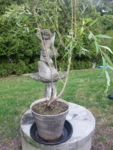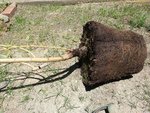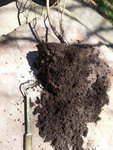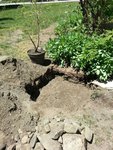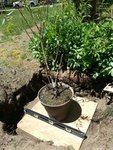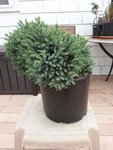Thank you for the kind words. Much appreciated.
Blue star juniper is excellent material to get started with, because it will be totally hardy outdoors all winter, and because it is readily available, modestly priced and grows pretty rapidly for a juniper. Its foliage is attractive, though not as easily refined as an Itoigawa or Kishu cultivar of Shimpaku juniper. But that is okay. It is a good start. I like what I see.
Wait a few weeks after the summer solstice, and then you can start thinning out the juniper. Do not prune out more than 25% to 35% of the foliage, you don't want to over do it.
Start by removing branches that obviously won't be needed. For these, always leave a fairly long ''stump'', which later you will strip the bark of an create a deadwood feature out of if they are in ''good spots'' for it. When I say branches that won't be needed, I mean where you have tight clusters of branches from a single point. Here you reduce to 3 branches, then a year or two later reduce to 2 branches. Reason to keep one extra is that until you thin it out, you want to keep styling options open. 3 branches at a node will not rapidly produce reverse taper, where higher number of branches at a single point will quickly produce unwanted bulges and lumps. Reverse taper is often worried about but is really not a big deal, a little is no problem at all.
So go through and remove obvious unneeded branches. If you can't decide? Do nothing for a bit.
Get yourself a few golf tees of different colors, rotate the tree several times. For one tee think only about the surface roots and first inch of trunk - mark the spot where this looks best with a golf tee or bamboo skewer stuck in the soil of the pot around the outside perimeter of the pot. Or make a mark on the pot. White chalk works on terra cotta.
The rotate the tree again, ignoring roots, and just look at the first branches from the trunk, mark the viewpoint that looks best with a golf tee.
Then ignore all else and look where the finer branching and foliage looks best. Add a golf tee marker
Then look for special features, in junipers this is often a piece of deadwood, or it could be a branch with a particularly nice curve. Mark the front for best viewing of this feature.
Now step back and look at where the marks ended up being. More often than not they will be clustered, and tend to be on opposite sides of the tree. This is a clue that those 2 sides of the tree could be your future front or back. Often in bonsai the front and back are relatively easy to switch between without major restyling.
The identification of a ''special feature'' is often the clue as to what direction you should take the tree to style it. Look for a flowing line, with nice movement.
Doing this exercise every few years with a tree will significantly help you in styling the tree. Having friends do it with you, give them each their own color golf teas, see if they see the same things you do. It is marvelously instructive.
If you don't take off too much foliage * less than 30%, you can repot in late summer or early autumn. I would say right about a week or two before the autumnal equinox. Say September 1 to 15. There is a burst of root growth that happens just after the equinox that will help the juniper recover from repotting. Don't repot too late in the season. You need 10 to 12 weeks before hard freezing shuts down root growth for winter. When you repot you can expose the base of the tree and get a good look at the nebari, Look, make note, take a picture then bury the nebari at least 1/2 inch deep in potting mix. Nebari develops best when buried. Expose the nebari on a young tree in development and it will never develop to its full potential.
Following year after repotting, no pruning until autumn. Then take it easy (less than 30%) then the second growing season, after repotting, you can be much more aggressive.
How's that for a start?
And if you feel confused, do nothing. I often let a new acquisition sit on my bench for a year or two just letting it grow and getting familiar with its looks.
Actually I have a fairly old, 40+ years old boxwood that has been sitting on my bench for over 10+ years, it is now approaching 55 or more years old. I still have not styled it. It is an ugly sucker and I can not for the life of me ''See the tree"" in there. But it has a damn nice trunk, I refuse to give it away or sell it, because damn it, I'm going to make something nice out of it eventually. But boxwoods that old and still fit in a 10 inch diameter bulb pan are not that common around here. So it sits waiting for me to get inspired. I got 3 different markers in the pot of possible fronts, have yet to pick one.
So there is nothing wrong with letting a tree grow on you a while.
